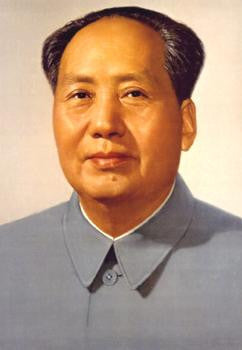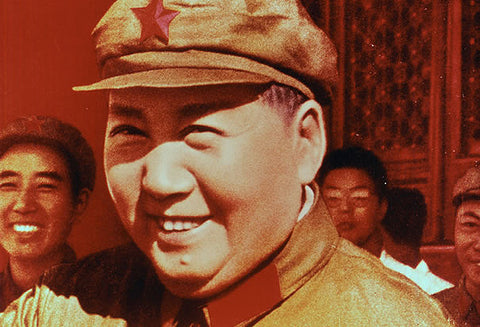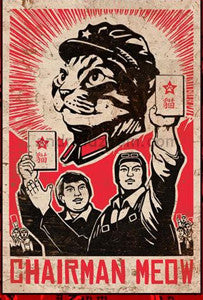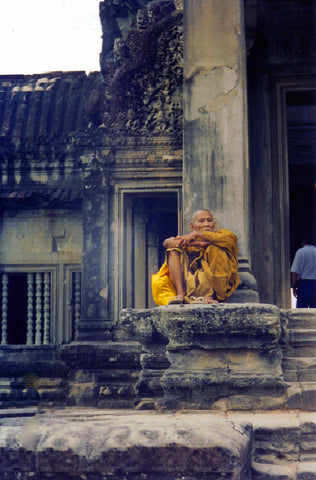Your Cart is Empty
Free Shipping for orders over $49 in Australia, $199 IN NEW ZEALAND/USA/CANADA AND $249 REST OF THE WORLD
Free Shipping for orders over $49 in Australia, $199 IN NEW ZEALAND/USA/CANADA AND $249 REST OF THE WORLD
Add description, images, menus and links to your mega menu
A column with no settings can be used as a spacer
Link to your collections, sales and even external links
Add up to five columns
Add description, images, menus and links to your mega menu
A column with no settings can be used as a spacer
Link to your collections, sales and even external links
Add up to five columns
What in the World About Mao: Transformation of Mao Zedong from Tyrant to Pop Icon is Nearly Complete
by Linda Heaphy May 10, 2017

Classic portraiture: Mao Zedong as he would like to be remembered by history
In summer I like to wear one of my favourite t shirts, bought in fashionable Shanghai clothing store Shirt Flag several years ago. One of their best sellers, it features a smiling elderly Mao Zedong in bright red and orange on a plain background of black. On this particular occasion I was accosted by the small, ancient Chinese lady who manned the organic vegetable stand at our local produce market. "Why you have him on your shirt?" she asked me. "Not good. This was a very bad man".
Mao Zedong is regarded as an iconoclastic figure in modern world history and was named one of the 100 most influential people of the 20th century by Time Magazine. Responsible for the Cultural Revolution and leader of China’s Communist Party between 1943 and 1976, he helped to establish the People's Republic of China and effectively led the country until his death in 1976. Ultimately though, he is seen as a controversial and divisive figure. He was a womaniser and a tyrant responsible for the deaths of between 40 and 70 million Chinese people and his reformist Marxist policies caused severe famine and irreparable damage to the culture and society of China. Today, however, Mao is undergoing an unprecedented rise in popularity throughout the world. His image, like that of Che Guevara, has transcended itself and his radical policies of peasant reform to become a part of western pop culture and a market leader in the antiques and collectibles market.

Chairman Mao in the popular press. Scanned from an original poster bought in Shanghai from the collection of a government press journalist. Photo credit: Kashgar
After Mao’s death in 1976 the Chinese government began a series of free market economic reforms and distanced themselves from his policies. As less recognition was given to the status of Mao, so too did his public profile decline. His statues were removed from civic areas and while his portrait appeared in the mid-1990s on all new renminbi currency, this was regarded as an anti-counterfeiting measure rather than as a mark of respect. In 2006, all mentions of Mae Zedong but one were removed from senior high school books; today Chinese students only learn of him in junior high school.
In spite of this, Mao’s cult of personality has flourished enormously over the years. During the Cultural Revolution Mao's took great care to ensure that his image was glorified and that his name became synonymous with the working class’s struggle against imperialism and capitalism, evils strongly associated with the western world. To many Chinese, especially those too young to have known deprivation during the Cultural Revolution, Mao became a God-like figure whose very image could expel evil spirits and bad luck. During his lifetime, a large but ultimately limited range of memorabilia, consisting mainly of poster and photographic images, china figures, badges and banners was created, while his Quotations From Chairman Mao Tse-Tung, also known as the Little Red Book, was mandatory reading for anyone who aspired to Communist Party membership.

Pop Mao lives on. Obey the Kitty's Chairman Meow

Andy Warhol's take on Mao the man

A Mao for the 21st Century as seen by Cafe Press

Shirt Flag's iconic rendering

Cheap and cheerful, these watches with Mao and waving hand are sold on every street corner in Chinese cities.
After his death, authentic Mao memorabilia quickly because desirable amongst collectors. The Chinese, ever quick to take advantage of such trends, began faking pieces for the international antique market, then created a thriving new industry off its back. They manufactured a vast range of pop culture items including statues, posters, t shirts, mugs, school items and watches, many of which display an irreverence not apparent in the originals. Today these items are as popular in China as they are in the west. Mao's granddaughter, Kong Dongmei, has discussed what she calls the "Red Culture" phenomenon, stating that "it shows his influence, that he exists in people's consciousness and has influenced several generations of Chinese people's way of life. Just like Che Guevara's image, his has become a symbol of revolutionary culture." However, as Ross Terril of the Washington Post writes, the rise in popularity of Pop Mao is more likely “a subtle mockery of the whole box and dice of Communist politics. It is also a symbol of commerce dethroning politics. That Mao is one of the ingredients tossed into the casserole of the market is itself a joke at the expense of socialism.” He goes on to note that many of the older traders who market the posters, busts and cassettes of Mao are former inmates of his labour camps. The very real terror that Mao inspired during his lifetime has been diffused and disempowered by the power of capitalism and free trade, concepts Mao once worked hard to eradicate.
As the market for Pop Mao items continues to grow, so have the rarer real memorabilia increased in value, not only to international buyers but to a new era of Chinese collectors grown affluent off the back of China’s economic surge. Some Cultural-Revolution-era badges and wool banners are now worth thousands of dollars. Within China itself is a huge market for authentic Mao stamps, ironic given that Mao himself detested stamp collecting as a bourgeois pursuit and banned it in China. In 2010, a Chinese auction saw a block of four stamps from 1968, depicting Chairman Mao standing alongside Lin Biao, sell for US$858,700. Similarly, Mao Zedong books from the Cultural Revolution era are gaining in value, making them ideal investment pieces. A first edition, first print of Mao's Quotations from Chairman Mao Zedong which featured the signature of Chinese military leader Lin Biao sold for US$12,256 in London in 2006. As usual with Chinese antiques it is a case of buyer beware. The Chinese are expert in art forgeries and porcelain buyers in particular should be wary.
Today, it’s not just about Mao’s image on objects. The latest craze in China is a growing assembly of Mao Zedong impersonators who appear not only in tv broadcasts, films and soap operas about the man, but also put in appearances at weddings, parties and banquets. Most of the doubles are not professional actors, do not belong to talent agencies and hold down other jobs. And far from performing satirical or comedic performances of Mao, a form of artistic expression generally unpopular in China, most reenact episodes of his early and political life, earnestly delivering his speeches in his own dialect and mannerisms, although renditions of Happy Birthday and personal messages to newlyweds are apparently very popular. Unlikely to ever become fashionable outside of China, the trend still points to an ongoing fascination with the man that is unlikely to end in the foreseeable future.

Mao Zedong impersonators are all the rage in China.
Photo by Tommaso Bonaventura courtesy of Wired
References and Further Reading
Chinese Mao Impersonators Are Devoid of Irony, Satire. By Pete Brook, 2010
Kong Dongmei: Inherited Her Grandfather's Character. All-China Women's Federation 2006
Look-a-like Chairman Mao Stirs Debate By He Na (China Daily). 2005
Mao Zedong. Wikipedia. Accessed 10th June 2011
Mao's Death, Legacy and Mao Memorabilia Jeffrey Hays, 2008 Last updated February 2011.
Red Stars Over China: the Mao Impersonators By David Moser. 2004
1 Response
Leave a comment
Comments will be approved before showing up.
Also in History
Articles
About the Author
- Linda has a Honours degree in Marine Biology and a PhD in Ecology from the University of NSW, Australia. She has travelled extensively and is a passionate writer on subjects as diverse as the role played by women throughout history, tribal communities and their customs, symbology and ethnology, talismans and their history. Occasionally she also writes about her travel experiences, her new life on a 25 acres in the Northern Rivers region of northern Australia and her black miniature poodle Phoenix. She is currently writing her first book on talismans.
About Us
-
The Kashgar Philosophy

Kashgar began through a love of travel.
In 1989 my father Bernard packed in his house painting business and set off for two years on a backpacking trek to the remotest corners of the world. When he finally arrived in the oasis city of Kashgar, China, he was so impressed with its history that he decided to start a new life collecting and selling exotic goods from all over the world. For 2000 years the legendary city of Kashgar was a melting pot of ideas and a key trading post on the historic Silk Road. It was this unique combination of philosophy and trade that my father wanted to recreate at home.
Starting in markets in 1991, he opened his first store in the Sydney suburb of Newtown in 1994. I gave up my own career as a government scientist to join him in 2000 and soon convinced my partner Ian to join us in what was to become the Family Business.
Today our version of Kashgar stocks a hugely diverse range of furniture, rugs, textiles, antiques, handicrafts and jewellery sourced from over twenty different countries including India, Nepal, Tibet, China, Thailand, Burma, Laos, the Philippines, Vietnam, Mexico, Peru, Turkey, Palestine, Syria, Afghanistan and Turkmenistan. Our collection includes contemporary and tribal silver and gold jewellery, a unique range of headhunting curios, antique Buddhist relics and a collection of one-off necklaces, earrings and bracelets that I design and create myself using the beads and jewellery making techniques of ethnic minorities from around the globe.
Kashgar is a philosophy as well as a store. We are committed to supporting traditional artisans and small village communities by selling authentic handcrafted goods which are personally collected by us. By supporting traditional methods of design and production we hope to encourage local cottage industries which have a low impact on the environment and help ethnic minorities maintain their self-sufficiency into the 21st Century. We are particularly committed to assisting women around the world and to this end have worked with several organisations including the Hua Bin Women's Union of Vietnam, the East Timorese Women's Association and Tikondane in Zambia. Time honoured means of craftsmanship and traditional ways of life are disappearing as people all over the world give up their identity in favour of jeans and T-shirts. We see our trade as a means of staving off the inevitable encroachment of the 21st century, assisting communities to decide for themselves which parts of the western world they wish to incorporate (medicine, education) and which they wish to reject (prostitution, drug production, begging and servitude to warlords). We encourage our customers to think of the handicrafts and artifacts they buy from us as an investment: a piece of history and a way of life that may soon be gone forever.
Kashgar has recently closed its retail outlet and gone completely online.
In the past our pieces appeared in many movies including The Hobbit, Mission Impossible 2, Queen of the Damned, Scooby Doo, Moulin Rouge and Wolverine, and in many televisions series, as well as in plays, commercials and exhibitions. We've found special pieces for individual customers as well as for film sets, event management companies, hotels, businesses, consulates and embassies. The uniqueness of our stock means that we are also very appealing to interior and fashion designers with a taste for the exotic.
There is something for everyone at Kashgar - collectors, the curious, those looking for a special present or for something unique to adorn the home. Most of our items are one-off specialties; other pieces we only stock in small quantities so as to continuously offer a wide and ever-changing range of interesting products. We are also packed with ideas for decorating home and work premises that will challenge your established concepts of design and storage.

Please enjoy - Linda Heaphy
Become a Kashgar nomad and join our mailing list...
Sign up to get the latest on sales, new releases and more …






julio larraz
December 19, 2023
People are fascinated by dictators with absolut power. Romano Mussolini,( the son of dictator Benito Mussolini ) wrote , that as a child he received fabulous presents from American captains of industry . Didn’t half of the US fell in love with Che, and Fidel ? no matter how much horror their subjects have to endure. Every thing is fun from far.